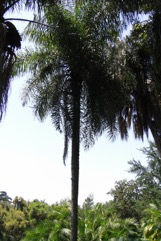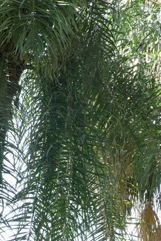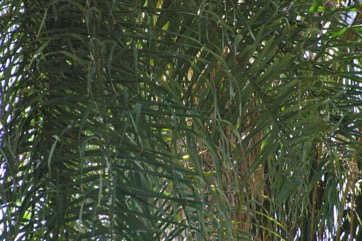Gru-Gru Palm, Macaw palm

A tropical plant. It needs well drained soil and good sun. It grows in savannah and open woodland, usually at low altitude. In Bolivia it grows to 900 m altitude. In Argentina it grows between 100-200 m above sea level. It suits hardiness zones 10-12.
Also known as:
Acrocome, Amankayo, Bacaiuva, Bocaiuva, Coco, Coco-baboso, Coco-depcatarro, Corocho de Jamaica, Corojo, Corozo, Coyol baboso, Coyoli palm, Coyolipalme, Gouglou, Glouglou, Grou-grou, Huana, Macacauba, Macajuba, Macauba palm, Macauva, Maguedji, Map, Mbocaya, Mucaia, Mucaja, Mucajuba, Mucuja palm, Namogoligi, Palma de coyol, Palmeira-macauba, Panima, Paraguay palm, Shodo, Suppa palm, Totai, Tucuma, Tuk', Uba, Ya cul
Synonyms
- Acrocomia antiguana L.H.Bailey
- Acrocomia antioquiensis Pusada-Arango
- Acrocomia belizensis L.H.Bailey
- Acrocomia christopherensis L.H.Bailey
- Acrocomia chunta Covas & Ragonese
- Acrocomia erioacantha Barb. Rodr.
- Acrocomia fusiformis (Sw.) Sweet
- Acrocomia glaucophylla Drude
- Acrocomia grenadana L.H.Bailey
- Acrocomia hospes L.H.Bailey
- Acrocomia ierensis L.H.Bailey
- Acrocomia intumescens Drude
- Acrocomia karukerana L.H.Bailey
- Acrocomia lasiospatha Mart.
- Acrocomia media O. F. Cook
- Acrocomia mexicana Karw. ex Mart.
- Acrocomia microcarpa Barb. Rodr.
- Acrocomia mokayayba Barb. Rodr.
- Acrocomia odorata Barb. Rodr.
- Acrocomia panamensis L.H.Bailey
- Acrocomia pilosa Leon
- Acrocomia quisqueyana L.H.Bailey
- Acrocomia sclerocarpa Mart.
- Acrocomia spinosa (Mill.) H. E. Moore
- Acrocomia subinermis Leon ex L.H.Bailey
- Acrocomia totai Mart.
- Acrocomia ulei Dammer
- Acrocomia viegasii L.H.Bailey
- Acrocomia vinifera Oerst.
- Acrocomia wallaceana Becc.
- Bactris globosa Gaertn.
- Bactris pavoniana Mart.
- Cocos aculeatus Jacq.
- Cocos fusiformis Sw.
- Euterpe aculeata (Willd.) Spreng.
- Palma spinosa Mill.
Edible Portion
- Kernels, Sap, Fruit, Nuts, Seeds, Cabbage, Young leaves, Palm heart, Oil
Where does Gru-Gru Palm grow?
Found in: Africa, Amazon, Antigua and Barbuda, Argentina, Australia, Belize, Bolivia, Brazil, Caribbean, Central America, Colombia, Costa Rica, Cuba, Dominica, East Africa, El Salvador, French Guiana, Grenada, Guatemala, Guianas, Guyana, Haiti, Honduras, Jamaica, Martinique, Mexico, Myanmar, North America, Pacific, Panama, Paraguay, Philippines, Puerto Rico, SE Asia, South America, St. Kitts and Nevis, St. Lucia, St. Vincent and Grenadines, Suriname, Tanzania, Trinidad and Tobago, Venezuela, West Indies
Notes: There are 2 Acrocomia species. This is a very variable species and may be one or 26 species. It has antihypovitaminosis A properties.
Status: It is cultivated for its fruit. The fruit are especially eaten by children.
Growing Gru-Gru Palm, Macaw palm
Cultivation: Plants can be grown from seed. Seed are difficult to germinate and this is improved by soaking in warm water or cracking the seed coat. Fresh seed should be planted. Seeds may take 1 year to sprout.
Edible Uses: The sap is used for palm wine. The kernels of the fruit are eaten raw. They have a coconut-like pulp. The palm cabbage is eaten. The outer husk or pulp is edible. The kernels contain cooking oil.
Production: Seedlings grow quickly and spines soon appear. The kernel contains 58% fat.
Nutrition Info
per 100g edible portion| Edible Part | Energy (kcal) | Protein (g) | Iron (mg) | Vitamin A (ug) | Vitamin c (mg) | Zinc (mg) | % Water |
|---|---|---|---|---|---|---|---|
| Seed | - | - | - | - | - | - | |
| Fruit | 286 | 2.76 | 0.8 | - | - | 2.2 | 34.3 |
| Palm heart | - | - | - | - | - | - | |
| Sap | - | - | - | - | - | - |
Gru-Gru Palm, Macaw palm Photos



References
Balick, M.J. and Beck, H.T., (Ed.), 1990, Useful palms of the World. A Synoptic Bibliography. Colombia p 50 (As Acrocomia vinifera), 58 (As Acrocomia vinifera), 73 (As Acrocomia totai), 113 (As Acrocomia totai), 163 (As Acrocomia sclerocarpa), 208 (As Acrocomia sclerocarpa), 295, 387 (As Acrocomia totai), 388 (As Acrocomia totai), 394 (As Acrocomia mexicana), 429 (As Acrocomia sclerocarpa), 556 (As Acrocomia mexicana), 561 (As Acrocomia antioquensis, Acrocomia ierensis and Acrocomia totai), 562 (As Acrocomia sclerocarpa), 598, 647, 658 (As Acrocomia belizensis, Acrocomia mexicana and Acrocomia vinifera), 659,
Biocyclopedia Edible Plant Species biocyclopedia.org (As Acrocomia lasiospatha and others)
Bircher, A. G. & Bircher, W. H., 2000, Encyclopedia of Fruit Trees and Edible Flowering Plants in Egypt and the Subtropics. AUC Press. p 7 (As Acrocomia antiquioensis and others)
Blomberry, A. & Rodd, T., 1982, Palms. An informative practical guide. Angus & Robertson. p 43 (As Acrocomia media and Acrocomia totai)
Bortolotto, I. M., et al, 2015, Knowledge and use of wild edible plants in rural communities along Paraguay River, Pantanal, Brazil. Journal or Ethnobiology and Ethnomedicine. 11:46
Bortolotto, I. M., et al, 2018, Lista preliminar das plantas alimenticias nativas de Mato Grosso do Sul, Brasil. Iheringia, Serie Botanica, Porto Alegre, 73 (supl.):101-116
Burkill, I.H., 1966, A Dictionary of the Economic Products of the Malay Peninsula. Ministry of Agriculture and Cooperatives, Kuala Lumpur, Malaysia. Vol 1 (A-H) p 39 (As Acrocomia sclerocarpa)
Chizmar Fernandez, C., et al, 2009, Plantas comestibles de Centroamerica. Instituto de Biodiversidad, Costa Rica. p 66
Etherington, K., & Imwold, D., (Eds), 2001, Botanica's Trees & Shrubs. The illustrated A-Z of over 8500 trees and shrubs. Random House, Australia. p 75
Etkin, N.L. (Ed.), 1994, Eating on the Wild Side, Univ. of Arizona. p 135 (As Acrocomia sclerocarpa)
Facciola, S., 1998, Cornucopia 2: a Source Book of Edible Plants. Kampong Publications, p 26 (Also as Acrocomia mexicana and Acrocomia sclerocarpa and Acrocomia totai)
Fagg, C. W. et al, 2015, Useful Brazilian plants listed in the manuscripts and publications of the Scottish medic and naturalist George Gardner (1812–1849). Journal of Ethnopharmacology 161 (2015) 18–29
Gibbons, M., 2003, A pocket guide to Palms. Chartwell Books. p 29
Grandtner, M. M., 2008, World Dictionary of Trees. Wood and Forest Science Department. Laval University, Quebec, Qc Canada. (Internet database http://www.WDT.QC.ca)
Grandtner, M. M. & Chevrette, J.,2013, Dictionary of Trees, Volume 2: South America: Nomenclature, Taxonomy and Ecology. Academic Press p 11
Haynes, J., & McLaughlin, J., 2000, Edible palms and Their Uses. University of Florida Fact sheet MCDE-00-50-1 p 2
Hedrick, U.P., 1919, (Ed.), Sturtevant's edible plants of the world. p 24 (As Acrocomia lasiospatha, Acrocomia mexicana, Acrocomia sclerocarpa)
Heindorf, C., 2011, Analysis of the Agrobiodiversity of Home Gardens in the Tropical Regions of Mexico. M.Sc. thesis. Cologne University of Applied Sciences. (As Acrocomia mexicana)
Henderson, A., Galeano, G and Bernal, R., 1995, Field Guide to the Palms of the Americas. Princeton. p 166
Hist. nat. palm. 3:286. 1845
Hunter, D., et al, 2019, The potential of neglected and underutilized species for improving diets and nutrition. Planta (2019) 250:709-729
INFOODS:FAO/INFOODS Databases (Also as Acrocomia mokayayba)
Jamaica: A country report to the FAO International Technical Conference on Plant Genetic Resources for Food and Culture. 2008 (As Acrocomia spinosa)
James, A., 2009, Notes on the Uses of Dominica's Native Palms. Palms, Vol. 53(2): p 62
Janick, J. & Paul, R. E. (Eds.), 2008, The Encyclopedia of Fruit & Nuts. CABI p 83
Johnson, D.V., 1998, Tropical palms. Non-wood Forest products 10. FAO Rome. p 90
Jones, D.L., 1994, Palms throughout the World. Smithtonian Institution, Washington. p 55, 56, 58
Jones, D.L., 2000, Palms of Australia 3rd edition. Reed/New Holland. p 112
Jones, D.L., 2000, Palms of Australia 3rd edition. Reed/New Holland. p 112 (As Acrocomia media)
Kermath, B. M., et al, 2014, Food Plants in the Americas: A survey of the domesticated, cultivated and wild plants used for Human food in North, Central and South America and the Caribbean. On line draft. p 19
Kiple, K.F. & Ornelas, K.C., (eds), 2000, The Cambridge World History of Food. CUP p 1805
Kujawska, M. & Luczaj, L., 2015, Wild Edible Plants Used by the Polish Community in Misiones, Argentina. Human Ecology 43:855-869
Lentz, D. L., 1986, Ethnobotany of the Jicaque of Honduras. Economic Botany 40(2):210-219 (As Acrocomia mexicana)
Lentz, D. L., 1993, Medicinal and Other Economic Plants of the Paya of Honduras. Economic Botany, Vol. 47, No. 4, pp. 358-370 (As Acrocomia mexicana)
Leticia, Z., et al, 2015, Do Socioeconomic characteristics explain the knowledge and use of native food plants in semiarid environments in Northeastern Brazil? Journal of Arid Environments 115:53-61
Lorenzi, H., 2002, Brazilian Trees. A Guide to the Identification and Cultivation of Brazilian Native Trees. Vol. 01 Nova Odessa, SP, Instituto Plantarum p 288
Lorenzi, H., Bacher, L., Lacerda, M. & Sartori, S., 2006, Brazilian Fruits & Cultivated Exotics. Sao Paulo, Instituto Plantarum de Estuados da Flora Ltda. p 62
Marcia, M. J., et al, 2011, Palm Uses in Northwestern South America: A Quantitative Review. Bot. Rev. (2011) 77:462-570
Martin, F.W. & Ruberte, R.M., 1979, Edible Leaves of the Tropics. Antillian College Press, Mayaguez, Puerto Rico. p 96, 209 (As Acrocomia sclerocarpa)
Menninger, E.A., 1977, Edible Nuts of the World. Horticultural Books. Florida p 124 (As Acrocomia media)
Menninger, E.A., 1977, Edible Nuts of the World. Horticultural Books. Florida p 124 (Also as Acrocomia totai)
Miguel, E., et al, 1989, A checklist of the cultivated plants of Cuba. Kulturpflanze 37. 1989, 211-357
Mutchnick, P. A. and McCarthy, B. C., 1997, An Ethnobotanical Analysis of the Tree Species Common to the Subtropical Moist Forests of the Peten, Guatemala. Economic Botany, Vol. 51, No. 2, pp. 158-183 (As Acrocomia mexicana)
NYBG herbarium "edible"
Oliviera V. B., et al, 2012, Native foods from Brazilian biodiversity as a source of bioactive compounds. Food Research International 48 (2012) 170-179
Plants of Haiti Smithsonian Institute http://botany.si.edu
Paz, F. S., et al, 2021, Edible Fruit Plant Species in the Amazon Forest Rely Mostly on Bees and Beetles as Pollinators. Journal of Economic Entomology, XX(XX), 2021, 1–13 (As Acrocomia sclerocarpa Mart.)
Riffle, R.L. & Craft, P., 2003, An Encyclopedia of Cultivated Palms. Timber Press. p 21, 22, 243
Rodriguez-Amaya, D. B., 1999, Carotenoides y Prepracion de Alimentos. University Estadual de Campinas, Brasil, Ph.D. thesis. p 25 (As Acrocomia makayayba)
Scarpa, G. F., 2009, Wild food plants used by the indigenous peoples of South American Gran Chaco: A general synopsis and intercultural comparison. Journal of Applied Botany and Food Quality 83:90-101
Schmedia-Hirschmann, G., 1994, Plants resources Used by the Ayoreo of the Paraguayan Chaco. Economic Botany Vol. 48. No. 3. pp. 252-258
Segura, S. et al, 2018, The edible fruit species in Mexico. Genet Resour Crop Evol (2018) 65:1767–1793 (Also as Acrocomia mexicana)
Standley, P. & Steyermark, J., 1958, Flora of Guatemala. Fieldiana: Botany, Volume 24 part 1 p 347 (As Acrocomia mexicana)
Steggerda, M., Some Ethnological Data Concerning One Hundred Yucatan Plants. Smithsonian Institution Anthropological Papers, No. 29 (As Acrocomia mexicana)
TodaFruta.com.br (As Acrocomia totai)
Turreira-Garcia, N., et al, 2015, Wild edible plant knowledge, distribution and transmission: a case study of the Achi Mayans of Guatemala. Journal of Ethnobiology and Ethnomedicine. 11:52
USDA, ARS, National Genetic Resources Program. Germplasm Resources Information Network - (GRIN). [Online Database] National Germplasm Resources Laboratory, Beltsville, Maryland. Available: www.ars-grin.gov/cgi-bin/npgs/html/econ.pl (10 April 2000)
Usher, G., 1974, A Dictionary of Plants Used by Man. Constable. p 19 (As Acrocomia mexicana and Acrocomia totai)
Vasquez, Roberto Ch. & Coimbra, German S., 1996, Frutas Silvestres Comestibles de Santa Cruz. p 152
Vazquez-Garcia. V., 2008, Gender, ethnicity, and economic status in plant management: Uncultivated edible plants among the Nahuas and Popolucas of veracruz, Mexico. Agriculture and Human Values 25: 65-77 (As Acrocomia mexicana)
Villachica, H., (Ed.), 1996, Frutales Y hortalizas promisorios de la Amazonia. FAO, Lima. p 261 (As Acrocomia totai)
Wickens, G.E., 1995, Edible Nuts. FAO Non-wood forest products. FAO, Rome. p161 (Also as Acrocomia totai)
World Checklist of Useful Plant Species 2020. Royal Botanic Gardens, Kew
Zambrana, P, et al, 2017, Traditional knowledge hiding in plain sight – twenty-first century ethnobotany of the Chácobo in Beni, Bolivia. Journal of Ethnobiology and Ethnomedicine (2017) 13:57
Zuchowski W., 2007, Tropical Plants of Costa Rica. A Zona Tropical Publication, Comstock Publishing. p 380